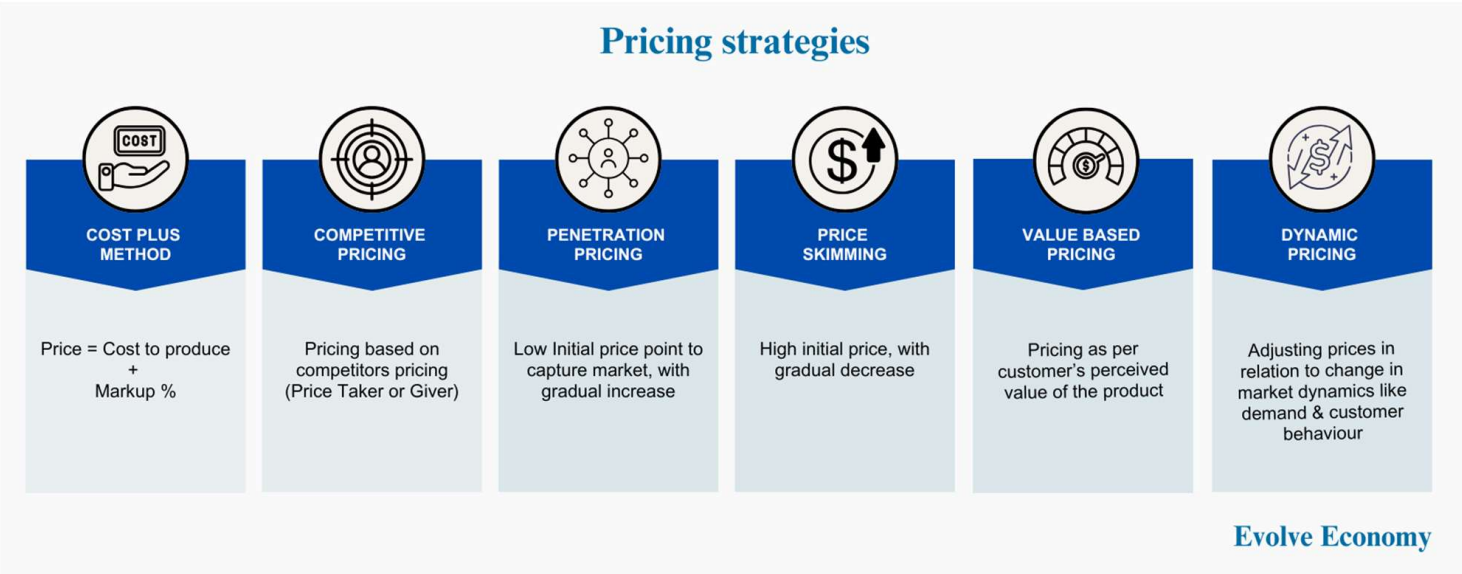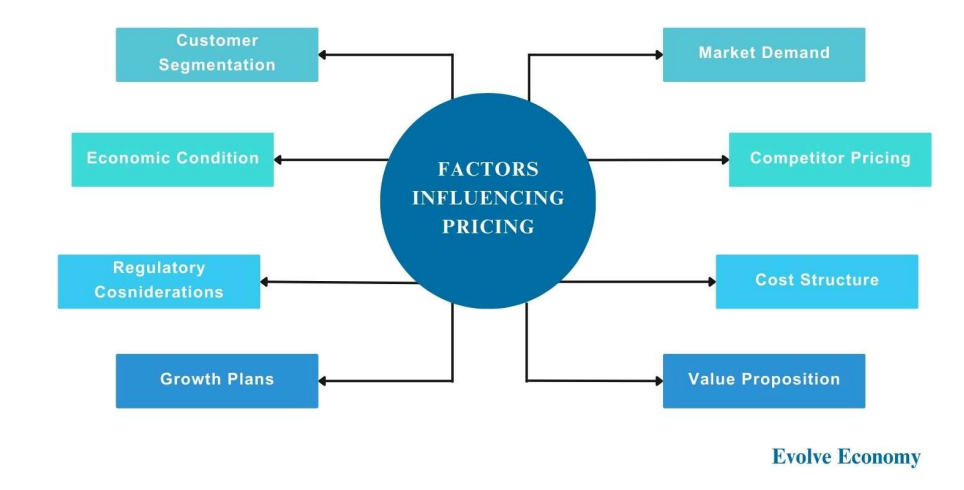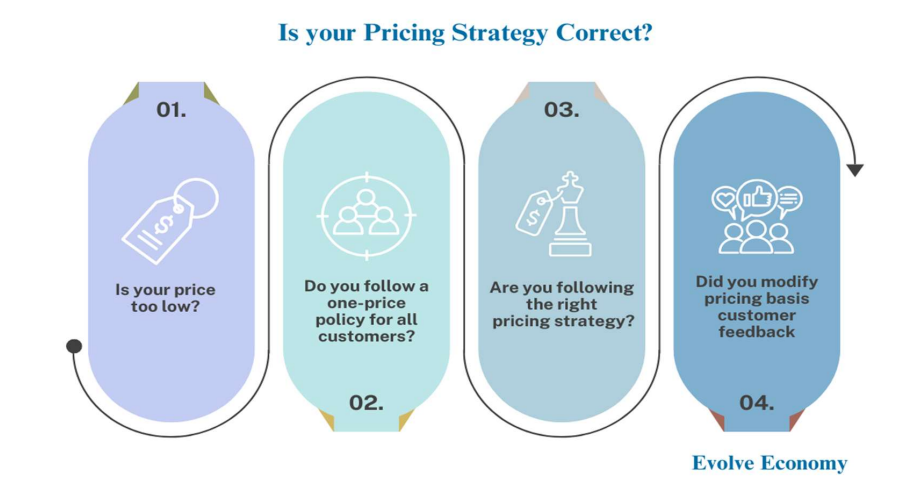A strategic guide to effective pricing
A well-planned pricing strategy ensures revenue generation, builds customer loyalty, and fosters brand identity. Conversely, an inappropriate pricing approach can lead to over/under pricing and miscommunication regarding the product’s value.
So, how can the startups strike the right balance? What pricing strategies should they adopt? What challenges should they anticipate?
This guide explores key pricing strategies, models, common mistakes and best practices to help startups navigate pricing effectively.
Key Pricing Strategies
A startup pricing strategy is a structured approach used to determine the optimal price of a product or service. Startups can implement a single strategy or a combination of multiple strategies based on their industry, competition, and business goals.

- Cost-Plus Pricing
Cost-plus pricing involves calculating the total cost of production and adding a markup to ensure profitability.
- Suitable for: Retail, hardware, and manufacturing.
- Advantages: Ensures cost coverage and guarantees a profit margin.
- Disadvantages: Ignores market demand and competition.
- Example: DMart
- Competitive Pricing
Competitive pricing involves analysing competitors’ pricing and positioning the product/service accordingly.
- Suitable for: E-commerce, SaaS, and telecom.
- Advantages: Keeps the product competitive.
- Disadvantages: Can lead to price wars and reduced profit margins.
- Example: Flipkart
- Penetration Pricing
Startups using penetration pricing set lower prices to attract customers quickly and build a strong market presence before increasing prices gradually.
- Suitable for: New startups entering competitive markets.
- Advantages: Helps build a customer base quickly.
- Disadvantages: Increasing prices later may be challenging.
- Example: Jio
- Price Skimming
With price skimming, businesses start with a high price and gradually lower it as market demand decreases or competition increases.
- Suitable for: Innovative technology products.
- Advantages: Maximises revenue from early adopters.
- Disadvantages: May alienate price-sensitive customers.
- Example: Apple iPhone
- Value-Based Pricing
Value-based pricing sets the price based on the perceived value to the customer rather than production costs.
- Suitable for: Luxury brands, premium SaaS, and consulting services.
- Advantages: Maximizes profits based on customer perception.
- Disadvantages: Requires in-depth market and customer research.
- Example: Starbucks
- Dynamic Pricing
Dynamic pricing adjusts prices based on demand, customer behaviour, and market conditions.
- Suitable for: E-commerce, hospitality, and ride-sharing apps.
- Advantages: Optimises revenue potential.
- Disadvantages: This may create dissatisfaction if pricing appears inconsistent.
- Example: Uber
Factors Influencing Pricing Decisions
Pricing isn’t just about what seems fair—it’s influenced by several internal and external factors.

- Market Demand: Understanding customer’s willingness to pay.
- Competitor Pricing: Staying competitive within the market.
- Cost Structure: Ensuring that pricing covers operational and production costs.
- Value Proposition: Justifying the price through product benefits.
- Customer Segmentation: Offering different pricing tiers based on customer groups.
- Economic Conditions: Inflation, recession, and market trends.
- Regulatory Considerations: Compliance with industry regulations.
- Scalability and Growth Plans: Ensuring pricing supports long-term expansion.
Common Pricing Models for Startups
To implement an effective pricing strategy, startups must adopt a pricing model that aligns with their business structure and customer expectations.
- One-Time Payment Model
Customers pay a single fee to purchase a product or service.
- Suitable for: Physical products, e-books, and online courses.
- Advantages: Simple and easy to understand.
- Disadvantages: Lacks recurring revenue.
- Example: Dell Laptop
- Subscription-Based Pricing
Customers pay a recurring fee (monthly or annually) for continuous access to a product or service.
- Suitable for: SaaS, content platforms, and membership-based businesses.
- Advantages: Provides predictable revenue and fosters customer loyalty.
- Disadvantages: Requires continuous value delivery.
- Example: Netflix
- Freemium Model
Offers a basic version of a product or service for free while charging for premium features.
- Suitable for: SaaS, mobile apps, and media streaming.
- Advantages: Builds a large user base.
- Disadvantages: Free users may never convert to paying customers.
- Example: Spotify Free
- Usage-Based Pricing
Charges customers based on their actual usage of the product or service.
- Suitable for: Cloud services, utilities, and telecom.
- Advantages: Customers only pay for what they use.
- Disadvantages: Revenue can be unpredictable.
- Example: Tata Power
- Tiered Pricing
Offers multiple pricing tiers with varying features to cater to different customer segments.
- Suitable for: SaaS, professional services, education and training.
- Advantages: Appeals to a broader customer base.
- Disadvantages: Too many options can create confusion.
- Example: Zoho
- Bundling Strategies
Selling multiple products or services together at a discounted price to increase value perception.
- Suitable for: E-commerce, financial services, and software suites.
- Advantages: Encourages higher purchase volume and increases perceived value.
- Disadvantages: May reduce the perceived worth of individual products.
- Example: MS Office Suite
Common Mistakes in Pricing
Even with a solid pricing strategy, startups often encounter challenges.

Lack of Pricing Strategy
- Startups often set prices on an ad-hoc basis, relying on their assumptions and limited data.
- Lack of a structured pricing strategy can lead to inconsistent brand positioning and loss of perceived value.
Squeezed Margins
- Startups often operate with thin margins initially to capture market share.
- If customers perceive the product’s value as low, raising prices later can be challenging.
- Sustained low margins can make the business unviable in the long run.
One-price for Multiple Segments
- Startups often adopt a single pricing strategy across multiple geographies.
- Different regions can have varying costs to serve and distinct customer segments.
- A one-price policy may lead to missed pricing opportunities in high-value markets and potential losses in costlier ones.
Failing to Test and Iterate
- Businesses do not test and experiment with different pricing models.
- Customer data and feedback should be used to identify the right pricing model.
Best Practices for Pricing
To optimise pricing, startups should follow these best practices.
- Align Pricing with Business Goals
Whether focusing on market penetration, revenue growth, or premium positioning, pricing should support the startup’s broader objectives.
- Conduct Market Research
Analyse customer needs, competitor pricing, and industry trends.
- Monitor Costs and Margins
Keeping a check on the costs and margins helps the company to play with different models and strategies.
- Communicate Value Clearly
Ensure customers understand the benefits and uniqueness of the product to justify pricing.
- Differentiate Pricing for Sales Channels
Ensure pricing strategies align with direct sales, marketplaces, retail partners, or subscription models to maximise reach and revenue.
- Use Data-Driven Pricing
Leverage analytics and customer insights to refine pricing models.
- Test and Iterate
Experiment with different pricing strategies and adjust based on customer response.
- Stay Flexible and Adaptive
Adjust the pricing based on market trends, customer feedback, economic shifts, and business growth stages.
Pricing is a dynamic and strategic component of a startup’s success. By understanding different pricing strategies and models, startups can position themselves effectively, attract the right customers, and maximise revenue.
Get in touch with us today to decode the right pricing strategy for you!